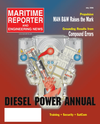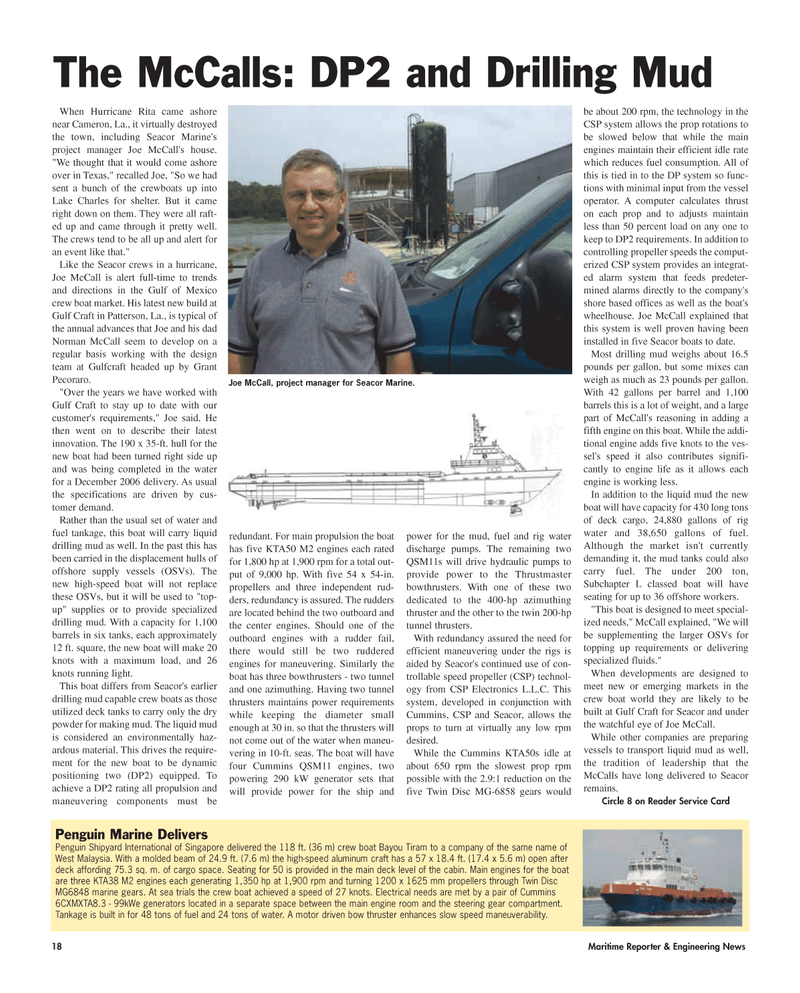
Page 18: of Maritime Reporter Magazine (July 2005)
The Satellite Communications Edition
Read this page in Pdf, Flash or Html5 edition of July 2005 Maritime Reporter Magazine
18 Maritime Reporter & Engineering News
When Hurricane Rita came ashore near Cameron, La., it virtually destroyed the town, including Seacor Marine's project manager Joe McCall's house. "We thought that it would come ashore over in Texas," recalled Joe, "So we had sent a bunch of the crewboats up into
Lake Charles for shelter. But it came right down on them. They were all raft- ed up and came through it pretty well.
The crews tend to be all up and alert for an event like that."
Like the Seacor crews in a hurricane,
Joe McCall is alert full-time to trends and directions in the Gulf of Mexico crew boat market. His latest new build at
Gulf Craft in Patterson, La., is typical of the annual advances that Joe and his dad
Norman McCall seem to develop on a regular basis working with the design team at Gulfcraft headed up by Grant
Pecoraro. "Over the years we have worked with
Gulf Craft to stay up to date with our customer's requirements," Joe said. He then went on to describe their latest innovation. The 190 x 35-ft. hull for the new boat had been turned right side up and was being completed in the water for a December 2006 delivery. As usual the specifications are driven by cus- tomer demand.
Rather than the usual set of water and fuel tankage, this boat will carry liquid drilling mud as well. In the past this has been carried in the displacement hulls of offshore supply vessels (OSVs). The new high-speed boat will not replace these OSVs, but it will be used to "top- up" supplies or to provide specialized drilling mud. With a capacity for 1,100 barrels in six tanks, each approximately 12 ft. square, the new boat will make 20 knots with a maximum load, and 26 knots running light.
This boat differs from Seacor's earlier drilling mud capable crew boats as those utilized deck tanks to carry only the dry powder for making mud. The liquid mud is considered an environmentally haz- ardous material. This drives the require- ment for the new boat to be dynamic positioning two (DP2) equipped. To achieve a DP2 rating all propulsion and maneuvering components must be redundant. For main propulsion the boat has five KTA50 M2 engines each rated for 1,800 hp at 1,900 rpm for a total out- put of 9,000 hp. With five 54 x 54-in. propellers and three independent rud- ders, redundancy is assured. The rudders are located behind the two outboard and the center engines. Should one of the outboard engines with a rudder fail, there would still be two ruddered engines for maneuvering. Similarly the boat has three bowthrusters - two tunnel and one azimuthing. Having two tunnel thrusters maintains power requirements while keeping the diameter small enough at 30 in. so that the thrusters will not come out of the water when maneu- vering in 10-ft. seas. The boat will have four Cummins QSM11 engines, two powering 290 kW generator sets that will provide power for the ship and power for the mud, fuel and rig water discharge pumps. The remaining two
QSM11s will drive hydraulic pumps to provide power to the Thrustmaster bowthrusters. With one of these two dedicated to the 400-hp azimuthing thruster and the other to the twin 200-hp tunnel thrusters.
With redundancy assured the need for efficient maneuvering under the rigs is aided by Seacor's continued use of con- trollable speed propeller (CSP) technol- ogy from CSP Electronics L.L.C. This system, developed in conjunction with
Cummins, CSP and Seacor, allows the props to turn at virtually any low rpm desired.
While the Cummins KTA50s idle at about 650 rpm the slowest prop rpm possible with the 2.9:1 reduction on the five Twin Disc MG-6858 gears would be about 200 rpm, the technology in the
CSP system allows the prop rotations to be slowed below that while the main engines maintain their efficient idle rate which reduces fuel consumption. All of this is tied in to the DP system so func- tions with minimal input from the vessel operator. A computer calculates thrust on each prop and to adjusts maintain less than 50 percent load on any one to keep to DP2 requirements. In addition to controlling propeller speeds the comput- erized CSP system provides an integrat- ed alarm system that feeds predeter- mined alarms directly to the company's shore based offices as well as the boat's wheelhouse. Joe McCall explained that this system is well proven having been installed in five Seacor boats to date.
Most drilling mud weighs about 16.5 pounds per gallon, but some mixes can weigh as much as 23 pounds per gallon.
With 42 gallons per barrel and 1,100 barrels this is a lot of weight, and a large part of McCall's reasoning in adding a fifth engine on this boat. While the addi- tional engine adds five knots to the ves- sel's speed it also contributes signifi- cantly to engine life as it allows each engine is working less.
In addition to the liquid mud the new boat will have capacity for 430 long tons of deck cargo, 24,880 gallons of rig water and 38,650 gallons of fuel.
Although the market isn't currently demanding it, the mud tanks could also carry fuel. The under 200 ton,
Subchapter L classed boat will have seating for up to 36 offshore workers. "This boat is designed to meet special- ized needs," McCall explained, "We will be supplementing the larger OSVs for topping up requirements or delivering specialized fluids."
When developments are designed to meet new or emerging markets in the crew boat world they are likely to be built at Gulf Craft for Seacor and under the watchful eye of Joe McCall.
While other companies are preparing vessels to transport liquid mud as well, the tradition of leadership that the
McCalls have long delivered to Seacor remains.
Circle 8 on Reader Service Card
The McCalls: DP2 and Drilling Mud
Joe McCall, project manager for Seacor Marine.
Penguin Marine Delivers
Penguin Shipyard International of Singapore delivered the 118 ft. (36 m) crew boat Bayou Tiram to a company of the same name of
West Malaysia. With a molded beam of 24.9 ft. (7.6 m) the high-speed aluminum craft has a 57 x 18.4 ft. (17.4 x 5.6 m) open after deck affording 75.3 sq. m. of cargo space. Seating for 50 is provided in the main deck level of the cabin. Main engines for the boat are three KTA38 M2 engines each generating 1,350 hp at 1,900 rpm and turning 1200 x 1625 mm propellers through Twin Disc
MG6848 marine gears. At sea trials the crew boat achieved a speed of 27 knots. Electrical needs are met by a pair of Cummins 6CXMXTA8.3 - 99kWe generators located in a separate space between the main engine room and the steering gear compartment.
Tankage is built in for 48 tons of fuel and 24 tons of water. A motor driven bow thruster enhances slow speed maneuverability.
MR JULY2006 #3 (17-24).qxd 7/5/2006 11:38 AM Page 18

 17
17

 19
19
